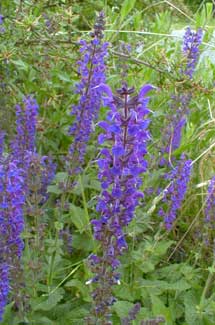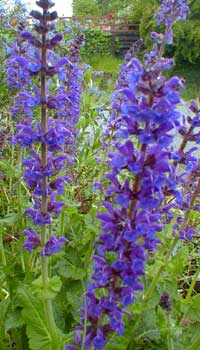
'May Night' Meadow Sage;
aka, 'Mainacht' Violet Sage;
aka, Balkan Clary
"As new-waked from soundest sleep,
Soft on the flowery herb I found me laid,
In balmy sweat, which with his beams the Sun
Soon dried, & on the reeking moisture fed."
-John Milton
(1608-1674)
(1608-1674)
Salvia x sylvestris is a cultivation name for hybrid sages derived chiefly from S. nemorosa (or S. virgata var. nemorosa ), native to Europe & Central Asia. Varieties are often tagged by nurseries by the alternate cultivation name S. x superba, if not tagged with the taxonomically more sound species name S. nemerosa.
Most cultivars have been achieved by selective interspecies crosses of S. nemerosa with its own variants & subspecies found throughout its extensive range, some of which themselves have botanical arguments for being separate species or not. Plus these selectively bred interspecies hybrids can be crossed with other closely related species. Purely wild forms are rarely gardened.
 In the case of the specific German cultivar 'Mainacht,' it began as an intraspecies hybrid of S. nemerosa pollinated by a similarly blue-spiked European sage, S. amplexicaulis (formerly S. villicaulis).
In the case of the specific German cultivar 'Mainacht,' it began as an intraspecies hybrid of S. nemerosa pollinated by a similarly blue-spiked European sage, S. amplexicaulis (formerly S. villicaulis).There are also a number of common names for S. x sylvestris aka S. x superba aka S. nemerosa including Violet Sage, Ornamental Meadow Sage, Balkan Clary, Purple Flowering Sage, or Perennial Woodland Sage. The cultivars are commonly designated Wild Sage, even though they are plant breeder creations; they certainly give a wildflower impression, in the best sense.
German breeders in particular have been developing sundry strains for over half a century. Names like 'Mainacht' tend to be changed one country to the next, & sometimes a single variety ends up with two or three names even just in English, though 'Mainacht' at least translated quite simply as 'May Night,' so has only these two names.
One of the showiest temperate sages, 'Mainacht' has compact upright stalks of indigo-lavender flowers in late spring throughout summer & for our temperate zone, rebloom for September & August, if the spent summer flowers are properly deadheaded. A bit of flowering is apt to linger even into winter. In our zone sages can look very nice throughout the winter, but are very worn by early spring & so can look a bit scraggly until mid spring.
'May Night' received the Perennial of the Year Award for 1997. This award pretty much guarantees a winner's wide distribution through the nursery trade, as it is given by professional growers & landscapers of the Perennial Plant Association.
It does well in poor sandy soil & if it likes its location it can spread very quickly. Too rich a soil can actually shorten the lives of sages. 'Mainacht' may overwhelm & displace nearby flowers that are less aggressive. Ours is hemmed around by other sturdy salvias & sun-loving herbs, including the dark-stemmed S. nemerosa 'Caradonna', the variegated S. officinalis 'Tricolor' & the sturdiest of all hyssops, Agastache rugosa. None of these are apt to displace any of the others; all are very hardy herbs.
In areas of excess heat & humidity 'May Night' is apt to become floppy rather than compact & upright, while in the coldest areas of its zone tolerances it will die back & require winter mulching. In our moderate weather on Puget Sound, it is nearly evergreen, but is best cut back late in winter to start over, or it will be awfully slow to recover in spring. It has never been even slightly tippy in our garden, never needing staking.
If they like their location they're extremely longlived perennials, but in rainy winters there is some risk of the dormant roots rotting away, which is usually ameliorated by sharply draining soil. Using lots of large-sized maple leaves or big fern fronds to mulch around the bases of plants that are especially sensitive to winter rot can actually barrier the soil against too much rain absorption in a given spot.
Its spikes make excellent cut flowers. Leaves rather than the flowers are aromatic. As a culinary herb the youngest leaves are good in moderation in raw salads, but better for baked casaroles or fried dishes.
As a medicinal herb the species has been used, as have other salvias, for all manner of illnesses. Some medicinal uses are founded on idle superstition, others no doubt have a measurably healthful effectivity. A mouse study conducted by Hosseinzadeh & Amel of Mashal University of Medical Science, School of Pharmacy, in Iran, found that S. sylvestris in particular had chemical properties useful in treating allergies, even though some people will instead be allergic to sages.